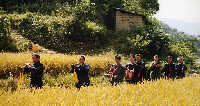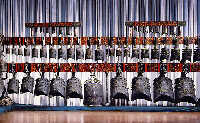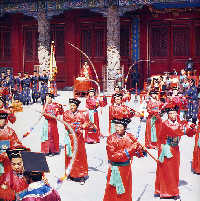
 Soli
Soli
 As Chinese saying goes: "Songs originated from the appearance of human being." "There are many kinds of music in Heaven and Earth." Chinese soli of instrumental music to a larger extent vividly reflects the long history, the diversity, strong local flavors and uniqueness of Chinese folk instrumental music culture. As for the playing of different folk instruments, there are a great many talents all over the country The multiethnic regions are usually famous for the specialty of their ethnic instruments and the specific playing forms, such as lusheng and zhixiaoqu of Sichuan and Hunan; rewapu and dutaer tanchang ofXinjiang; and eagle-bone fluteof Tibet and Qinghai.There is suona horn in Zhongyuan (the central plains), northeast China, and westeast China, which has a long history with rich connotation, simple styles and skillful playing. In southeast China, there are well-known hanyue zhengqu in Guangdong and minnan zhengqu in Fujian.
As Chinese saying goes: "Songs originated from the appearance of human being." "There are many kinds of music in Heaven and Earth." Chinese soli of instrumental music to a larger extent vividly reflects the long history, the diversity, strong local flavors and uniqueness of Chinese folk instrumental music culture. As for the playing of different folk instruments, there are a great many talents all over the country The multiethnic regions are usually famous for the specialty of their ethnic instruments and the specific playing forms, such as lusheng and zhixiaoqu of Sichuan and Hunan; rewapu and dutaer tanchang ofXinjiang; and eagle-bone fluteof Tibet and Qinghai.There is suona horn in Zhongyuan (the central plains), northeast China, and westeast China, which has a long history with rich connotation, simple styles and skillful playing. In southeast China, there are well-known hanyue zhengqu in Guangdong and minnan zhengqu in Fujian.
 Tutti
Tutti
 mong tutti, the popular ones are blowing music with drumbeats, blowing and percussion music, music of gong-and-drum, and sizhu music.
mong tutti, the popular ones are blowing music with drumbeats, blowing and percussion music, music of gong-and-drum, and sizhu music.
As the old poem lines go: "The wind and drum flute and xiao can attract fairies; while the suona horn can make devils leave." As life is full of happiness and joy, as well as grief and misery, music is one of the fittest music that can make one enjoy life with abandon. The main instruments of this music are suona horn,guanziand flute; the minor ones are percussion instruments.
Among national folk instrumental music culture, wind and drum music is the most widely and longest spread one for it is most closely connected with custom traditions and has the richest humane values and music art values. So far, on most occasions such as festivals, weddings, funerals, celebrating the one-month old of a newborn, birthday celebration, beam placing, this music is widely heard.
Wind music with drumbeats accounts for a large portion in this collection.
 Blowing and percussion music is of similar importance as wind and drum music in north China such as shanxi, and has similar features and functions in South China.
Blowing and percussion music is of similar importance as wind and drum music in north China such as shanxi, and has similar features and functions in South China.
As the ancient poem lines go: "We worship our ancestors with music of qin, se and drum to pray for rain for the crops to stimulate our morale" Like drumbeat music, music of gong-and-drum has a long history and is colorful all over the country It is a popular folk art on the occasions such as festivals and celebrations and has taken deep root in local life. They are full of local flavors and cultural aesthetic meanings, among which, the most famous ones areJiangzhougong-and-drum music of Shanxi;shehuogong-and-drum music of Qinghai; Zhoushan gong-and-drum of Zhejiang;Daliuzi of Tujia ethnic group of Hunan;Chaozhoudaluogu of Guangdong. There are immeasurable cultural and art values in its music structure, colorful rhythms, moving expressive forms and deep music meanings.
As the ancient poem lines go: "Strings and Bamboos can make melodious music." Sizhu music or xiansuo music are popular practically all over the country, which is characterized by its special characters and lasting taste. In the north China, there are errentai paiziqu of Shanxi andInner Mongolia; xiansuo shisantao ofBeijing; pengbaban of Shandong; and bantouqu of Henan; in south China, the playing and enjoying of sizhu music such as Guangdong music, Jiangnan sizhu, Fujian nanyin has become a unique pastime.
 Court Music
Court Music
 There is a record about music in "Yugua in Tijing: "Emperors in ancient times eulogized virtues with music and made sacrifice to the God with magnificent music." Since the beginning of the Chinese nation, virtually all the dynasties have had the tradition that emperors eulogized virtues with music; therefore, court music is a national music with rich historical connotations. Since the establishment of the system of "music under government control" in the Northern Wei Dynasty, most of court musicians are from this system, which is especially obvious in the Ming andQing DynastyThat is to say, court is a place not only for the development and spreading of folk music, and court music is the flowering and polishing of folk music. As a result, Beijing Volume, Hebei Volume and Inner Mongolia Volume include some numbers of court music.
There is a record about music in "Yugua in Tijing: "Emperors in ancient times eulogized virtues with music and made sacrifice to the God with magnificent music." Since the beginning of the Chinese nation, virtually all the dynasties have had the tradition that emperors eulogized virtues with music; therefore, court music is a national music with rich historical connotations. Since the establishment of the system of "music under government control" in the Northern Wei Dynasty, most of court musicians are from this system, which is especially obvious in the Ming andQing DynastyThat is to say, court is a place not only for the development and spreading of folk music, and court music is the flowering and polishing of folk music. As a result, Beijing Volume, Hebei Volume and Inner Mongolia Volume include some numbers of court music.
 Sacrificial Music
Sacrificial Music
 There are descriptions for folk sacrificial scenes of dancing and singing in "Donghuang taiyi" and "Dongjun" of Jiuge byQu Yuan(a great ancient Chinese poet). For a long time, people like to highlight ethnic and tribal cultures with ritual music so as to achieve the effect of mystery and shock. Inner Mongolia Volume and Heilongjiang Volume include Shamanist sacrificial music, which reflect the characteristics of local sacrificial music cultures of Mongolia ethnic group, Dawoer ethnic group, Ewenke ethnic group, Elunchun ethnic group and Hezhe ethnic group. Hunan Volume and Guizhou Volume also include music for sacrificial ritual and religious ceremonies, which reflect the local customs of communication between man and god, and the customs of making sacrifice to spirits. Shandong Volume, Beijing Volume and Hunan Volume include some numbers of music for sacrifice toConfucius, which reflect the fact that Chinese people of different times have placed a stress on Confucian culture.
There are descriptions for folk sacrificial scenes of dancing and singing in "Donghuang taiyi" and "Dongjun" of Jiuge byQu Yuan(a great ancient Chinese poet). For a long time, people like to highlight ethnic and tribal cultures with ritual music so as to achieve the effect of mystery and shock. Inner Mongolia Volume and Heilongjiang Volume include Shamanist sacrificial music, which reflect the characteristics of local sacrificial music cultures of Mongolia ethnic group, Dawoer ethnic group, Ewenke ethnic group, Elunchun ethnic group and Hezhe ethnic group. Hunan Volume and Guizhou Volume also include music for sacrificial ritual and religious ceremonies, which reflect the local customs of communication between man and god, and the customs of making sacrifice to spirits. Shandong Volume, Beijing Volume and Hunan Volume include some numbers of music for sacrifice toConfucius, which reflect the fact that Chinese people of different times have placed a stress on Confucian culture.
 Religious music
Religious music
 The collection includes a lot of music numbers ofBuddhism, Taoism and Islam, from which we can know their basic styles, for there is rich cultural information in the three religions.
The collection includes a lot of music numbers ofBuddhism, Taoism and Islam, from which we can know their basic styles, for there is rich cultural information in the three religions.

Presented by Chinadaily.com.cn Registration Number: 10023870-7
Copyright © Ministry of Culture, P.R.China. All rights reserved